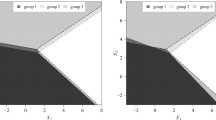Abstract
We consider the mixing proportion π in a mixture of two independent distributions, and establish the expression of its posterior density, in closed form and in terms of L 1-norms of various related functions, using a prior beta and the optimal classification rule for the two populations provided by Discriminant analysis. A numerical example fully illustrates the concepts presented.
Similar content being viewed by others
References
Bolotin VV (1969) Statistical methods in structural mechanics. Holden-Day, San Francisco
Clemons TE, Bradley EL Jr (2000) A non-parametric measure of the overlapping coefficient. Comput Stat Data Anal 34:51–61
Devroye L, Gyorfi L (1985) Non-parametric density estimation, the L1 View. Wiley, New York
Exton H (1976) Multiple hypergeometric functions and applications. Chichester-Ellis Howard, London
Everitt BS (1985) Mixture distributions. In: Johnson N, Kotz S (eds) Encyclopedia of statistical sciences, vol 5, pp 559–569
Gastwirth JL (1975) Statistical measures of earnings differentials. Am Stat 29:32–35
Inman HF, Bradley EL (1989) The overlapping coefficient as a measure of agreement between probability distributions and point estimation of the overlap of two normal densities. Commun Stat Theory Methods 18:3851–3874
James IR (1978) Estimation of the mixing proportion in a mixture of two normal distributions from simple, rapid measurements. Biometrics 34:265–278
Johnson N, Kotz S, Balakhrishnan N (1995) Continuous univariate distributions, vol 2. Wiley, New York
Krishnan T (2001) Imperfect supervision in statistical pattern recognition. In: Pal SK, Pal A (eds) Pattern Recognition, from Classical to Modern Approaches. World Scientific, Singapore, pp 25–65
McLachlan GJ, Basford K (1988) Mixture Models. Marcel Dekker, New York
Mulekar MS, Mishra SN (1994) Overlap coefficients of two normal densities: equal means case. J Jpn Stat Soc 34:169–180
Pham-Gia T (2004) Bayes Inference. In: Gupta AK, Nadarajah S (eds) Handbook of the beta distribution. Marcel Dekker, New York, pp 361–422
Pham-Gia T, Tran Loc H (2001) The mean and median absolute deviations. Math Comput Model 34:921–936
Pham-Gia T, Turkkan N (1992a) Bayes binomial sampling by attributes with a general beta prior. IEEE Trans Reliab 4:310–316
Pham-Gia T, Turkkan N (1992b) Sample size determination in bayesian analysis. The Statistician 41(4):389–397
Pham-Gia T, Turkkan N, Duong QP (1992c) Using the mean deviation in the determination of the prior distribution. Stat Prob Lett 13:373–381
Rahme E, Joseph L, Gyorkos TW (2000) Bayesian sample size determination for estimating binomial parameters from data subject to misclassification. Appl Stat 49:119–128
Rao CR (1988) Methodology Based on the L1-norm in Statistical Inference. Sankhya 50:289–313
Reiser B, Faraggi D (1999) Confidence Intervals for the overlapping coefficient: the normal equal variance case. Statistician 48:413–418
Sneath PHA (1977) A method for testing the distinctness of clusters: a test of the disjunction of two clusters in euclidean space, as measured by their overlap. Math Geol 9:123–143
Styne RA, Heyse JF (2001) Non-parametric estimates of overlap. Stat Med 20:215–236
Titterington DM (1997) Mixture distributions. In: Johnson N, Kotz S (eds) Encyclopedia of statistical sciences, vol 1 , pp 399–407
Titterington DM, Smith AFM, Makov UE (1985) Statistical analysis of mixture distributions. Wiley, Chichester, London
Turkkan N, Pham-Gia T (1993) Computation of the highest posterior density interval in bayesian analysis. J Stat Comput Simul 44:243–250
Author information
Authors and Affiliations
Corresponding author
Additional information
Research partially supported by CRSNG 9249 (Canada). The authors wish to thank the Faculty of Science and the Department of Statistics of UNISA for their generous support that has led to this joint work. Also, thanks to Ms. Jeannette LeBlanc for her excellent technical support, and to an anonymous referee for very helpful comments that have helped to improve the presentation of the paper.
Rights and permissions
About this article
Cite this article
Pham-Gia, T., Turkkan, N. & Bekker, A. Bayesian Analysis in the L 1-Norm of the Mixing Proportion Using Discriminant Analysis. Metrika 64, 1–22 (2006). https://doi.org/10.1007/s00184-006-0027-1
Received:
Published:
Issue Date:
DOI: https://doi.org/10.1007/s00184-006-0027-1
Keywords
- Overlapping coefficient
- Discriminant analysis
- L 1-distance
- Misclassification
- Hypergeometric functions
- Highest posterior density
- Beta distribution




